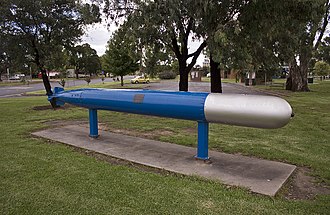
A modern torpedo is a self-propelled weapon with an explosive warhead, launched above or below the water surface, propelled underwater towards a target, and designed to detonate either on contact with its target or in proximity to it.
Historically, it was called an automotive, automobile, locomotive or fish torpedo; colloquially called a fish. The term torpedo was originally employed for a variety of devices, most of which would today be called mines. From about 1900, torpedo has been used strictly to designate an underwater self-propelled weapon.
While the battleship had evolved primarily around engagements between armoured ships with large-caliber guns, the torpedo allowed torpedo boats and other lighter surface ships, submersibles, even ordinary fishing boats or frogmen, and later, aircraft, to destroy large armoured ships without the need of large guns, though sometimes at the risk of being hit by longer-range shellfire.
Today's torpedoes can be divided into lightweight and heavyweight classes; and into straight-running, autonomous homers, and wire-guided. They can be launched from a variety of platforms.
Contents
Etymology
The word torpedo comes from the name of a genus of electric rays in the order Torpediniformes, which in turn comes from the Latin "torpere" (to be stiff or numb). In naval usage, the American Robert Fulton introduced the name to refer to a towed gunpowder charge used by his French submarine Nautilus (first tested in 1800) to demonstrate that it could sink warships.
History
Middle Ages
The concept of a torpedo existed many centuries before it was later successfully developed. In 1275, Hasan al-Rammah described "...an egg which moves itself and burns."
In modern language, a 'torpedo' is an underwater self-propelled explosive, but historically, the term also applied to primitive naval mines. These were used on an ad hoc basis during the early modern period up to the late 19th century. Early spar torpedoes were created by the Dutchman Cornelius Drebbel in the employ of King James I of England; he attached explosives to the end of a beam affixed to one of his own submarines and they were used (to little effect) during the English expeditions to La Rochelle in 1626.
An early submarine, the Turtle, attempted to lay a bomb with a timed fuse on the hull of HMS Eagle during the American Revolutionary War, but failed in the attempt.
In the early 1800s, the American inventor Robert Fulton, while in France, "conceived the idea of destroying ships by introducing floating mines under their bottoms in submarine boats." He coined the term "torpedo" in reference to the explosive charges with which he outfitted his submarine Nautilus. However, both the French and the Dutch governments were uninterested in the submarine. Fulton then concentrated on developing the torpedo independent of a submarine deployment. On 15 October 1805, while in England, Fulton put on a public display of his "infernal machine", sinking the brig Dorothea with a submerged bomb filled with 180 lb (82 kg) of gunpowder and a clock set to explode in 18 minutes. However, the British government refused to purchase the invention, stating they did not wish to "introduce into naval warfare a system that would give great advantage to weaker maritime nations." Fulton carried out a similar demonstration for the US government on 20 July 1807, destroying a vessel in New York's harbor. Further development languished as Fulton focused on his "steam-boat matters". During the War of 1812, torpedoes were employed in attempts to destroy British vessels and protect American harbors. In fact a submarine-deployed torpedo was used in an unsuccessful attempt to destroy HMS Ramillies while in New London's harbor. This prompted the British Capt. Hardy to warn the Americans to cease efforts with the use of any "torpedo boat" in this "cruel and unheard-of warfare", or he would "order every house near the shore to be destroyed."
Torpedoes were used by the Russian Empire during the Crimean War in 1855 against British warships in the Gulf of Finland. They used an early form of chemical detonator.
During the American Civil War, the term torpedo was used for what is today called a contact mine, floating on or below the water surface using an air-filled demijohn or similar flotation device. These devices were very primitive and apt to prematurely explode. They would be detonated on contact with the ship or after a set time, although electrical detonators were also occasionally used. USS Cairo was the first warship to be sunk in 1862 by an electrically detonated mine. Spar torpedoes were also used; an explosive device was mounted at the end of a spar up to 30 feet (9.1 m) long projecting forward underwater from the bow of the attacking vessel, which would then ram the opponent with the explosives. These were used by the Confederate submarine H. L. Hunley to sink USS Housatonic although the weapon was apt to cause as much harm to its user as to its target. Rear Admiral David Farragut's famous/apocryphal command during the Battle of Mobile Bay in 1864, "Damn the torpedoes, full speed ahead!" refers to a minefield laid at Mobile, Alabama.
On 26 May 1877, during the Romanian War of Independence, the Romanian spar torpedo boat Rândunica attacked and sank the Ottoman river monitor Seyfi. This was the first instance in history when a torpedo craft sank its targets without also sinking.
Invention of the modern torpedo
In 1866 British engineer Robert Whitehead invented the first effective self-propelled torpedo, the eponymous Whitehead torpedo. French and German inventions followed closely, and the term torpedo came to describe self-propelled projectiles that traveled under or on water. By 1900, the term no longer included mines and booby-traps as the navies of the world added submarines, torpedo boats and torpedo boat destroyers to their fleets.
A prototype self-propelled torpedo was created by a commission placed by Giovanni Luppis, an Austro-Hungarian naval officer from Fiume (now Rijeka, Croatia), a port city of the Austro-Hungarian Monarchy, and Robert Whitehead, an English engineer who was the manager of a town factory. In 1864, Luppis presented Whitehead with the plans of the salvacoste (coastsaver), a floating weapon driven by ropes from the land that had been dismissed by the naval authorities due to the impractical steering and propulsion mechanisms.
Whitehead was unable to improve the machine substantially, since the clockwork motor, attached ropes, and surface attack mode all contributed to a slow and cumbersome weapon. However, he kept considering the problem after the contract had finished, and eventually developed a tubular device, designed to run underwater on its own, and powered by compressed air. The result was a submarine weapon, the Minenschiff (mine ship), the first modern self-propelled torpedo, officially presented to the Austrian Imperial Naval commission on December 21, 1866.
The first trials were not successful as the weapon was unable to maintain a course at a steady depth. After much work, Whitehead introduced his "secret" in 1868 which overcame this. It was a mechanism consisting of a hydrostatic valve and pendulum that caused the torpedo's hydroplanes to be adjusted so as to maintain a preset depth.
Production and spread
After the Austrian government decided to invest in the invention, Whitehead started the first torpedo factory in Fiume. In 1870, he improved the devices to travel up to approximately 1,000 yd (910 m) at a speed of up to 6 kn (11 km/h), and by 1881 the factory was exporting torpedoes to ten other countries. The torpedo was powered by compressed air and had an explosive charge of gun-cotton. Whitehead went on to develop more efficient devices, demonstrating torpedoes capable of 18 kn (33 km/h) in 1876, 24 kn (44 km/h) in 1886, and, finally, 30 kn (56 km/h) in 1890.
Royal Navy representatives visited Fiume for a demonstration in late 1869, and in 1870 a batch of torpedoes was ordered. In 1871, the British Admiralty paid Whitehead £15,000 for certain of his developments and production started at the Royal Laboratories in Woolwich the following year. In 1893, RN torpedo production was transferred to the Royal Gun Factory. The British later established a Torpedo Experimental Establishment at HMS Vernon and a production facility at the Royal Naval Torpedo Factory, Greenock in 1910. These are now closed.
Whitehead opened a new factory near Portland Harbour, England in 1890, which continued making torpedoes until the end of the Second World War. Because orders from the RN were not as large as expected, torpedoes were mostly exported. A series of devices was produced at Fiume, with diameters from 14 in (36 cm) upward. The largest Whitehead torpedo was 18 in (46 cm) in diameter and 19 ft (5.8 m) long, made of polished steel or phosphor bronze, with a 200-pound (91 kg) gun-cotton warhead. It was propelled by a three-cylinder Brotherhood engine, using compressed air at around 1,300 psi (9.0 MPa) and driving two contra-rotating propellers, and was designed to self-regulate its course and depth as far as possible. By 1881, nearly 1500 torpedoes had been produced. Whitehead also opened a factory at St Tropez in 1890 that exported torpedoes to Brazil, Holland, Turkey and Greece.
Whitehead purchased rights to the gyroscope of Ludwig Obry in 1888 but it was not sufficiently accurate, so in 1890 he purchased a better design to improve control of his designs, which came to be called the "Devil's Device". The firm of L. Schwartzkopff in Germany also produced torpedoes and exported them to Russia, Japan and Spain. In 1885, Britain ordered a batch of 50 as torpedo production at home and at Fiume could not meet demand.
By World War I, Whitehead's torpedo remained a worldwide success, and his company was able to maintain a monopoly on torpedo production. By that point, his torpedo had grown to a diameter of 18 inches with a maximum speed of 30.5 knots (56.5 km/h; 35.1 mph) with a warhead weighing 170 pounds (77 kg).
Whitehead faced competition from the American Lieutenant Commander John A. Howell, whose own design, driven by a flywheel, was simpler and cheaper. It was produced from 1885 to 1895, and it ran straight, leaving no wake. A Torpedo Test Station was set up on Rhode Island in 1870. The Howell torpedo was the only United States Navy model until Whitehead torpedoes produced by Bliss and Williams entered service in 1894. Five varieties were produced, all 18 in (46 cm) diameter. The United States Navy started using the Whitehead torpedo in 1892 after an American company, E.W. Bliss, secured manufacturing rights.
Torpedo boats and guidance systems

Request Movie Now
Watch movie Torpedo online on Amazon
Watch movie Torpedo online
Watch The Movie On PrimeSohni Mahiwal (1984) Full HD Movie Download
.jpg)
Aafat Full HD Movie Download

Dekh Kabira Roya Full HD Movie Download

Laat Saab Full HD Movie Download

Dil Dosti etc. Full HD Movie Download

Delhi-6 Full HD Movie Download

Karma (Malayalam) Full HD Movie Download
.jpg)
Suhagan (1986) Full HD Movie Download
.jpg)
Aastha: In The Prison Of Spring Full HD Movie Download

Netrikkan Full HD Movie Download

Alibaba and 40 Thieves Full HD Movie Download

Jabilamma Pelli Full HD Movie Download

Indrajeet Full HD Movie Download

Sree Guruvayoorappan Full HD Movie Download

Bharath Talkies Lo Bombu Full HD Movie Download

Delhi Simham Full HD Movie Download

Chitti Chellelu Full HD Movie Download

Iddaruammayilu Full HD Movie Download

No Full HD Movie Download

Main Awara Hoon Full HD Movie Download

Bunty Aur Babli Full HD Movie Download

Download latest Movie from bollywood
- 1> baaghi 3
- 2> THE SKY IS PINK MOVIE FULL STORY AND REVIEW
- 3> Luka Chuppi
- 4> TO ALL THE BOYS I’VE LOVED BEFORE
- 5> Kabir Singh
- 6> Street Dancer 3D
- 7> Simmba
- 8> Gone Girl
- 9> The Girl Who Lived
- 10> Ludo
- 11> DILWALE DULHANIA LE JAYENGE
- 12> GUILTY
- 13> The Godfather
- 14> Adventures of Rusty
- 15> Sooryavanshi
- 16> Satyameva Jayate 2
- 17> Thappad
- 18> Bhool Bhulaiyaa 2
- 19> KGFChapter 2
- 20> Mardaani 2
- 21> Pinjar
- 22> Shivaji maharaj
- 23> Ek Villian 2
- 24> Hungama 2
- 25> Divergent
- 26> Mumbai Saga
- 27> The Internship
- 28> HIT (telugu)
- 29> Panga
- 30> The perfect date
- 31> 16 December
- 32> Gopala Gopala (Telugu)
- 33> Brahmastra
- 34> Gangubai Kathiawadi
- 35> Manmadhudu
- 36> Nenu local
- 37> Mahanati
- 38> Shatamanam bavathi
- 39> Lagaan
- 40> After
- 41> MOM
- 42> Shamshera
- 43> Raguvaran BTech
- 44> Khakee
- 45> The villain
- 46> OM
- 47> Mr. perfect
- 48> Bueatifull mind
- 49> Hichki
- 50> Gabbar Singh
- 51> Jogi
- 52> Before Sunrise
- 53> Before Sunset
- 54> Before Midnight
- 55> The Big Bull
- 56> Top Gun: Maverick
- 57> The Purge
- 58> The Sky is Pink
- 59> Laxmmi Bomb
- 60> Sadak 2
- 61> Sufna
- 62> Prithviraj
- 63> PK
- 64> Coolie No 1(2020)
- 65> Black Widow
- 66> Dear Zindagi
- 67> Dil Bechara
- 68> PHIR HERA PHERI
- 69> WAR
- 70> Dostana
- 71> RRR: Roudram Ranam Rudhiram
- 72> Maidan
- 73> Dabbang 3
- 74> Chhalaang
- 75> life as we know it
- 76> SherShaah
- 77> Sandeep Aur Pinky Faraar
- 78> Event Horizon
- 79> 83
- 80> Radhe: Your Most Wanted Bhai
- 81> Gunjan Saxena: The Kargil Girl
- 82> Mr India
- 83> Vivah
- 84> Anokha Bandhan
- 85> Ghost
- 86> Bhoot: Part One - The Haunted Ship
- 87> Haseen Dilruba
- 88> Laal Singh Chaddha
- 89> Qismat
- 90> Rajput
- 91> Drive
- 92> Dil Chahta Hai
- 93> Dil Ki Baazi
- 94> Dil Ka Rishta
- 95> Teesri Manzil
- 96> Dil
- 97> Love Aaj Kal
- 98> Khaali Peeli
- 99> Bunty Aur Babli 2
- 100> Atrangi Re
- 101> Gulabo Sitabo
- 102> Jodi
- 103> Suraj Pe Mangal Bhari
- 104> Deewana
- 105> Attack
- 106> Sardar Udham Singh
- 107> Toofan
- 108> THE LOVEBIRDS
- 109> Jersey
- 110> Ginny Weds Sunny
- 111> Thalaivi
- 112> Shiddat
- 113> Angels vs Zombies
- 114> Koi Mil Gya
- 115> Thank God
- 116> Bhuj: The Pride of India
- 117> Hum Aapke Hain Kaun
- 118> The Platform
- 119> Bird Box
- 120> Roohi Afzana
- 121> Torbaaz
- 122> Nikamma
- 123> World War Z
- 124> Extraction
- 125> Train to Busan
- 126> Life of Pi
- 127> SHAADI MEIN JROOR AANA
- 128> Himmat Aur Mehnat
- 129> To All The Boys: P.S. I Still Love You
- 130> Mimi
- 131> Good Newwz
- 132> Shubh Mangal Zyada Saavdhan
- 133> Raabta
- 134> Harry Potter and the Philosopher's Stone
- 135> Harry Potter and the Chamber of Secrets
- 136> Chhapaak
- 137> War of the Worlds
- 138> Harry Potter and the Prisoner of Azkaban
- 139> Harry Potter and the Goblet of Fire
- 140> MURDER MYSTERY
- 141> Shakuntala Devi
- 142> Bachchan Pandey
- 143> Jayeshbhai Jordar
- 144> Sheer Qorma
- 145> Saina
- 146> 'O' Pushpa I hate tears
- 147> Kedarnath
- 148> MS Dhoni The Untold Story
- 149> Chhichhore
- 150> Badhaai Ho
- 151> Unstoppable
- 152> Oz the Great And Powerful
- 153> The Girl on the Train
- 154> Haathi Mere Saathi 2020
- 155> The Conjuring: The Devil Made Me Do It
- 156> Gandhi Se Pehle Gandhi
- 157> The Song of Scorpions
- 158> Srimanthudu
- 159> Hello Guru Prema Kosame
- 160> Beauty and The Beast
- 161> Black Panther
- 162> Charlie and the Chocolate Factory
- 163> Bole Chudiyan
- 164> Fidaa
- 165> Duvvada Jagannadham
- 166> Bruce Lee: The Fighter
- 167> Hyper
- 168> Yaara
- 169> Red (2020)
- 170> Shivam
- 171> That Is Mahalakshmi
- 172> Nishabdham
- 173> Aashram 2020 web series
- 174> Laxmii
- 175> Mismatched
- 176> STUDENT OF THE YEAR 2
- 177> NAIL POLISH
- 178> Ramprasad Ki Tehrvi
- 179> KAAGAZ
- 180> 12 o Clock
- 181> The Power
- 182> bolo hau
- 183> Tribhanga
- 184> JAMUN
- 185> Madam Chief Minister
- 186> Maasaab
- 187> Aadhaar
- 188> Tanhaji
- 189> Bhaagi 3
- 190> Bhootnath
- 191> MALANG
- 192> Jai Mummy Di
- 193> Haathi Mere Saathi 2021
- 194> Shakeela
- 195> Unpaused
- 196> Annayya
- 197> Vamsoddharakudu
- 198> Mrugaraju
- 199> Narasimha Naidu
- 200> Sankranti
- 201> Manasu Maata Vinadhu
- 202> Anjaane
- 203> Apaharan
- 204> Bachke Rehna Re Baba
- 205> Bewafaa
- 206> Roohi
- 207> Radhe
- 208> Zindagi Khoobsoorat Hai
- 209> Yeh Mohabbat Hai
- 210> Yeh Kya Ho Raha Hai?
- 211> The Tomorrow War
- 212> DehradunDiary
- 213> Meri Shaadi Karaoo
- 214> Matruu Ki Bijlee Ka Mandola
- 215> No One Killed Jesica
- 216> Aag Ka Goola
- 217> Eight Million Dollars
- 218> Three Hundred
- 219> Cats and Dog
- 220> Decoy
- 221> Gold Rush
- 222> You Have Got Mail
- 223> Final Destination three
- 224> Tofan
- 225> Jungle
Request for Download movie Torpedo
- Bollywood movies
- Latest Bollywood movies
- Download all bengali movies
- Download all bhojpuri movies
- Download all english movies
- Download all gujarati movies
- Download all hindi movies
- Download all kannada movies
- Download all malayalam movies
- Download all marathi movies
- Download all oriya movies
- Download all punjabi movies
- Download all tamil movies
- Download all telugu movies
- Bollywood action movies
- Bollywood adventure movies
- Bollywood animation movies
- Bollywood classical movies
- Bollywood comedy movies
- Bollywood crime movies
- Bollywood devotional movies
- Bollywood documentary movies
- Bollywood drama movies
- Bollywood family movies
- Bollywood fantasy movies
- Bollywood historical movies
- Bollywood history movies
- Bollywood horror movies
- Bollywood musical movies
- Bollywood mystery movies
- Bollywood mythological movies
- Bollywood patriotic movies
- Bollywood romance movies
- Bollywood romantic movies
- Bollywood sci-fi movies
- Bollywood social movies
- Bollywood spiritual movies
- Bollywood sports movies
- Bollywood suspense movies
- Bollywood thriller movies
- Bollywood war movies
- Hot actress list
- Hot gujarati actress list
- Hot tamil actress list
- Hot bhojpuri actress list
- Hot assam actress list
- Hot bihari actress list
- Hot jammu and kashmir actress list
- Hot gujarati actress list
- Hot haryana actress list
- Hot konkani actress list
- Hot marathi actress list
- Hot odia actress list
- Hot punjabi actress list
- Hot rajasthani actress list
- Hot kannada actress list
- Hot malayalam actress list
- Hot telugu actress list
- Hot tulu actress list
- Hot Actress list from Indian city
- Hot actress list from ahmedabad
- Hot actress list from alappuzha
- Hot actress list from bangalore
- Hot actress list from bangalore
- Hot actress list from bhopal
- Hot actress list from chandigarh
- Hot actress list from chennai
- Hot actress list from guwahati
- Hot actress list from hyderabad, india
- Hot actress list from indore
- Hot actress list from jaipur
- Hot actress list from kannur
- Hot actress list from kochi
- Hot actress list from kolkata
- Hot actress list from kollam
- Hot actress list from kottayam
- Hot actress list from kozhikode
- Hot actress list from lucknow
- Hot actress list from madurai
- Hot actress list from mangalore
- Hot actress list from mumbai
- Hot actress list from mysore
- Hot actress list from new delhi
- Hot actress list from patna
- Hot actress list from pune
- Hot actress list from thiruvananthapuram
- Hot actress list from thrissur
- Hot actress list from tiruchirappalli
- Hot actress list from vijayawada
- Hot actress list from visakhapatnam
- All Bollywood Movies
- Bollywood Celeb
- >Art Director
- >Audiography
- >Background Music
- >Banner
- >Choreographer
- >Cinematographer
- >Costume Designer
- >Dialogue Writer
- >Director
- >Distributor
- >Editor
- >Executive Producer
- >Hair Stylist
- >Lyricist
- >Music Director
- >Photographer
- >Playback Singers
- >Presenter
- >Producer
- >Production Company
- >Production Designer
- >Screenplay
- >Singer
- >Sound
- >Actor
- >Story Writer
- >Studio
- >Video Director
- >Miscellaneous
- >Publicity (pro)
- >Web Creator
- >Production Labs
- >Publicity Design
- >Publicity Stills
- >Writer
- >Miscellaneous Artists
- >Visual Effects
- >Reporter
- >Music Company
- >Shooting Studios
- >Picturised On
- >Line Producer
- >Co Producer
- >Asst Director
- >Casting Director
- >Cinematography
- >Choreography
- >Dialouge
- >Editing
- >Lyrics
- >Music
- >Story
- >Playback Singer Female
- >Playback Singer Male
- >Actor In A Comic Role (male/female)
- >Child Artiste
- >Ensemble Cast
- >Actor Popular Choice (male)
- >Actor Popular Choice (female)
- >Sa Re Ga Ma Pa Song Of The Year
- >Actor In Supporting Role
- >Actress In Supporting Role
- >Actor In Leading Role
- >Art Direction
- >Actress In Leading Role
- >Sound Recording
- >Costume Design
- >Special Effects
- >Action
- >Actor In A Negative Role
- >Lifetime Achievement Award
- >Cinematic Exellence (director)
- >Cinematic Exellence (male)
- >Cinematic Exellence (female)
- >International Male Icon
- >International Female Icon
- >Actor In A Supporting Role (male)
- >Actor In A Supporting Role (female)
- >Actor In A Comic Role
- >Playback Singer (male)
- >Playback Singer (female)
- >Most Promising Debut (female)
- >Most Promising Debut (male)
- >Most Promising Director
- >Sound Design
- >Lifetime Jodi
- >Marketed Film
- >Jury Award For Best Actor
- >Jury Award For Best Actress
- >Jury Award For Best Film
- >Jury Award For Best Director
- >Playback Singer(male)
- >Lifetime Acheivement Award (male)
- >Excellence Award
- >Jodi Award
- >Performer Of The Year
- >Presented By